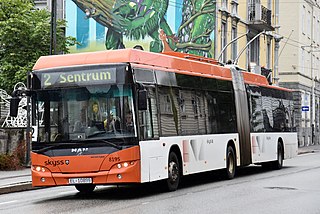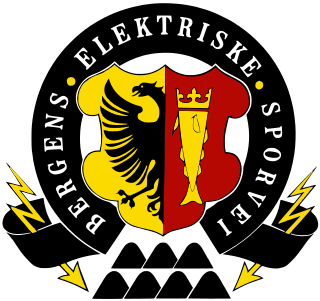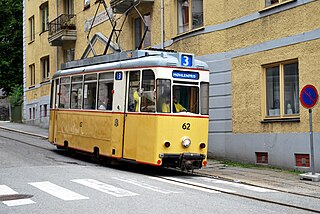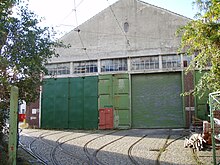
The Oslo Metro is the rapid transit system of Oslo, Norway, operated by Sporveien T-banen on contract from the transit authority Ruter. The network consists of five lines that all run through the city centre, with a total length of 85 kilometres (53 mi), serving 101 stations of which 17 are underground or indoors. In addition to serving 14 out of the 15 boroughs of Oslo, two lines run to Kolsås and Østerås, in the neighbouring municipality of Bærum. In 2016, the system had an annual ridership of 118 million.

Bergenhus is a borough of the city of Bergen in Vestland county, Norway. This borough encompasses the city centre and is the most urbanized area of the whole city. The 25.41-square-kilometre (6,280-acre) borough has a population (2014) of 40,606. This gives Bergenhus a population density of 1,598 inhabitants per square kilometre (4,140/sq mi).

Jernbanetorget is both a rapid transit station on the Oslo Metro and a tram stop of the Oslo Tramway. The metro station is in the Common Tunnel used by all lines under the city centre. It is located between Stortinget to the west and Grønland to the east. Until the construction of the station at Stortinget, Jernbanetorget was the end station for the eastern lines in downtown. Along with the Oslo Central Station, Oslo Bus Terminal and the tram and bus station above ground, Jernbanetorget is the largest transport hub in Norway.

The Røa Line is a rapid transit line of the Oslo Metro, Norway, which runs from Majorstuen in Oslo to Østerås in Bærum. It serves neighborhoods such as Smestad, Hovseter, Huseby and Røa in northwestern Oslo, and Grini, Øvrevoll and Østerås in northeastern Bærum. The line is served by Line 2 of the metro, which connects to the city center via the Common Tunnel and onwards along the Furuset Line. The lowest part of the Røa Line, consisting of two stations, is shared with the Kolsås Line, and thus also served by Line 2 of the metro. The Røa Line is owned by Kollektivtransportproduksjon, and operated by Oslo T-banedrift on contract with the public transport agency Ruter.

The Trondheim Tramway in Trondheim, Norway, is the world's most northerly tramway system, following the closure and dismantling of the Arkhangelsk tramways in Russia. It consists of one 8.8-km-long line, the Gråkallen Line, running from St. Olav's Gate in the city centre through Byåsen to Lian Station in Bymarka.

AS Oslo Sporveier is a defunct municipal owned company responsible for public transport in Oslo, Norway. It was created in 1924 to take over the city's two private tram companies. In 1927 its started with bus transport, including from 1940 to 1968 trolleybuses. Since 1966 rapid transit and from 1985 water buses have also been operated by the company. It was split into two separate companies in 2006; Kollektivtransportproduksjon took over the operation while Oslo Public Transport Administration was responsible for buying the services, fare regulation and marketing. The latter merged into Ruter in 2008, when the Oslo Sporveier brand was discontinued.

The Drammen trolleybus system was a system of trolleybuses in Drammen in Buskerud county, Norway, which operated between 15 December 1909 and 10 June 1967. The system stretched from the city center to Brakerøya, Merket and Vårveien and was operated by the companies Drammens Elektriske Bane, A/S Trikken and Drammen Kommunale Trikk. The system was well suited for Drammen, since the city has a lot of hills and cheap electricity.

The Bergen trolleybus system serves the city of Bergen, Norway. It is the only trolleybus system still in operation in Norway and one of two trolleybus systems in Scandinavia.

Bergen Light Rail is a light rail system in Bergen, Norway. The first stage of the project was a twenty-station stretch between the city center and Lagunen Storsenter, where the first 15 stations comprising a 9.8-kilometre (6.1 mi) stretch opened in 2010, and the second was a 3.6-kilometre (2.2 mi) stretch from Nesttun to Lagunen which opened in June 2013. A third stretch from Lagunen to Bergen Airport, Flesland opened in 2017. The second line between Kaigaten and Fyllingsdalen opened on 21 November 2022. Further plans for the project involve mooted extensions to Åsane and Storavatnet.

Bergen Sporvei AS was a municipal owned public transport company that operated in Bergen, Norway from 1898 to 1998. The company operated both the Bergen Tramway, Bergen trolleybus and the yellow buses in Bergen.

Nationaltheatret is an underground metro station and tram stop serving Vika and the city center of Oslo, Norway. It is located on the Common Tunnel of the Oslo Metro and on the Briskeby Line of the Oslo Tramway. Also located at the same place is Nationaltheatret Station of the Drammen Line. The station is served by all five lines of the metro, and lines 11 and 13 of the tramway. In addition, several bus services call at the station. It is named for the National Theatre located nearby.
A/S Kristiania Sporveisselskab or KSS, nicknamed the Green Tramway, was an operator of part of the Oslo Tramway from 1875 to 1924. The company was established in 1874 and started with horsecar operations on the Ullevål Hageby Line, Gamlebyen Line and the Grünerløkka–Torshov Line. The network was electrified with in 1899 and 1900, whereby the company was bought by Union-Elektricitäts-Gesellschaft. It delivered new Class U trams. Within a few years the company had also opened the Vålerenga Line and Kampen Line. It took over Kristiania Kommunale Sporveie in 1905, taking over its fleet of Class S trams and the Sagene Ring, the Vippetangen Line and the Rodeløkka Line.

Kristiania Kommunale Sporveie or KKS, colloquially known as the Red Tramway was a municipal owned company that operated parts of the Oslo Tramway from 1899 to 1905. KKS built and operated three lines, Sagene Ring, the Rodeløkka Line and the Vippetangen Line. The three were connected by means of lines of Kristiania Sporveisselskab (KSS) and Kristiania Elektriske Sporvei (KES). KKS bought twenty motorized trams from Schuckert & Co. and twelve trailers, designated as Class S. It built two depots, Sagene and Rodeløkka.
A/S Kristiania Elektriske Sporvei or KES, nicknamed the Blue Tramway, was a company which operated part of the Oslo Tramway between 1894 and 1924. It built a network of four lines in Western Oslo, the Briskeby Line and the Frogner Line which ran to Majorstuen, and two other consecutive lines, the Skøyen Line and the Lilleaker Line. These all connected to a common line through the city center which terminated at Jernbanetorget.

A/S Bærumsbanen was a tram company that operated the Lillaker-, Kolsås and Østensjø Line of the Oslo Tramway, Norway, from 1924 to 1971 when the company became part of Oslo Sporveier.

Lilleaker is a light rail station on the Oslo Tramway.

Bergen's Electric Tramway is an organization which operates a museum tramway in Møhlenpris in Bergen, Norway. The tramway is an attempt at a revival of the Bergen Tramway, which operated from 1897–1965.

The history of the Oslo Tramway and Oslo Metro in Oslo, Norway, starts in 1875, when Kristiania Sporveisselskab (KSS) opened two horsecar lines through the city centre. In 1894, Kristiania Elektriske Sporvei (KES) built the first electric street tramways, which ran west from the city centre. Within six years, all tramways were electric. The city council established Kristiania Kommunale Sporveie (KKS) in 1899, which built three lines before it was sold to KSS six years later. Both KSS and KES were taken over by the municipality in 1924, becoming Oslo Sporveier. The company gradually expanded the city tram network, which reached its peak length in 1939.

The Rodeløkka Line is a former line of the Oslo Tramway of Norway. It was in use from 1900 to 1961, serving the neighborhood of Rodeløkka. After closing, the southern part of the line was designated as part of the Sinsen Line. The Rodeløkka Line was built by Kristiania Kommunale Sporveie (KKS) in 1900, and was subsequently taken over by Kristiania Sporveisselskab (KSS) in 1905. In 1924, the ownership was transferred to Oslo Sporveier. It was served by Line 9 until 1949, when it was replaced by a bus service. In 1955, a new route from Carl Berners plass to Rodeløkka was built, and the line was served by Line 13 until 1961, when the service was terminated. The tracks were removed between 1962 and 1964.























